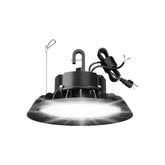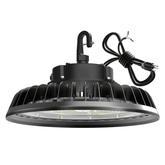Choosing High Bay LED Lights: A Complete Guide to Parameters
Choosing the right high-ceiling LED lights for your industrial or commercial facilities is a crucial decision that will affect visibility, power consumption, and long-term operating costs. It's not as simple as choosing regular bulbs. Selecting high-ceiling LED lights means understanding various key parameters to achieve the best performance and pay reasonable prices.
High-performance performance of the elevated LED lights: lumen efficiency (lm/W) and power (wattage)
Understanding lumen efficiency (lm/W)
Lumen efficiency is expressed as the number of lumens per watt (lm/W), and it is one of the most crucial indicators for measuring the efficiency of elevated LED lights. It shows the number of visible light (lumens) emitted by the lamp for every watt of electricity consumed. The higher the lm/W value, the higher the efficiency of the light, because more energy is converted into light and less energy is converted into waste heat, which directly means saving on electricity costs. When comparing elevated LED lights, always choose the one with a higher lumen efficiency.
Select the appropriate wattage based on the space
Although wattage is used to determine power consumption, the actual brightness produced depends on the total lumen output. Different wattages will have different lumen outputs. For example:
- A 100 watt high bay LED light can emit approximately 13,000 to 15,000 lumens of light.
- A 150 watt light can provide 19,500 to 22,500 lumens of light.
- A 200 watt light may emit 26,000 to 30,000 lumens of light.
- A 240 watt light may output 31,000 to 36,000 lumens of light or more.
- A 300W High Bay Light provide 45,000lm of light
- 400W High Bay Light may output 60,000 lumens of light
The size of your space, the height of the ceiling, and the required brightness level on the working surface (foot candles or lux) will determine the appropriate wattage (and thus the lumens output). In larger areas or on higher ceilings, a higher wattage/lumen high-gloss LED lamp is needed.

The clear and true colors of the high-ceiling LED lights: Color Temperature Index (CRI) and Color Rendering Index (CCT)
The Color Temperature Index (CRI) is used to measure how well a light source accurately represents the true color of objects compared to natural daylight. The range of CRI is from 0 to 100; 100 represents the ideal color reproduction. Generally, for most applications of high-ceiling LED lights, a CRI greater than 80 is considered good and suitable for manufacturing or general warehouse environments. However, in environments with extremely high requirements for color accuracy, such as retail environments, paint workshops, printing facilities, or comprehensive inspection seminars, an effect with a CRI higher than 90 is more ideal.
Measured in Kelvin (K), Color Temperature (CCT) can reflect the appearance of the light produced. For high-ceiling LED lights, the common color temperature types include:
- 4000K (Neutral White Light): It can provide balanced and clear light, suitable for working environments, and helps to improve work efficiency. It is suitable for general industrial and commercial places.
- 5000K (Cool White Light/Daylight): It simulates natural daylight and has excellent visibility and clarity. It is often used in warehouses, manufacturing factories, and large retail places because these places have higher requirements for high visibility.
- 6000K (Even Cooler Daylight): It is a very clear white light with a blue tint, sometimes used for tasks requiring extremely detailed processing or for creating very bright and stimulating environments.









